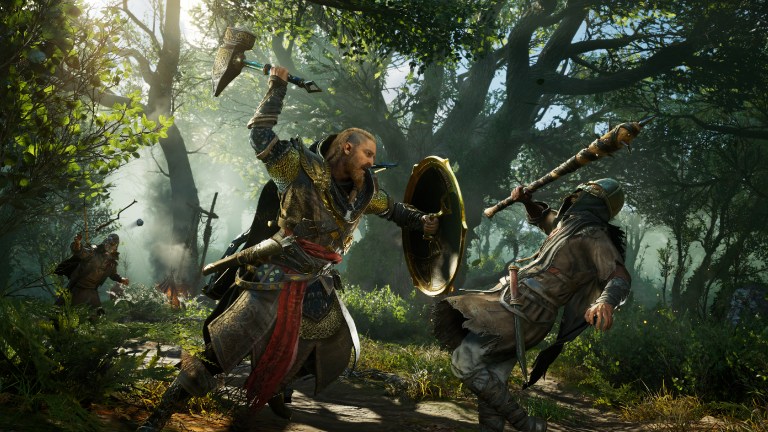Assassin’s Creed Valhalla Review
Assassin's Creed Valhalla brings the action-adventure franchise to next-gen consoles and to the era of Vikings.

Despite releasing 12 Assassin’s Creed installments since 2007, Ubisoft is still finding ways to keep the series fresh, and the latest sequel, Valhalla is one of the best titles yet. Is it a revelation for the series? No—there are very few new ideas presented here. But it’s a polished title with solid gameplay and a story that is exceedingly coherent for an open-world AAA title.
In Assassin’s Creed Valhalla, you play as Eivor, a fearsome Viking in 873 AD who lost her parents in battle, a moment that left her literally scarred and hellbent on getting revenge against the warlord who slaughtered them. It’s important to note that the game gives you the choice to play as a male or female version of Eivor at the start of the game, but you’re also given a third option that allows the Animus to “choose” the gender for you based on the memory being recollected. Theoretically, the game is then supposed to switch between male and female throughout the adventure, but despite letting the Animus choose, I remained female for most of my play time.
After an hours-long intro that sees you exploring and kicking ass across the mountainous terrain of Norway, Eivor and her brother Sigurd set out on a longship to start a new settlement of their own in England, where a majority of the game takes place. The game’s story is as violent and unflinching as you’d expect considering the milieu. Eivor and her crew of Vikings go to war with other clans, and she of course carries out missions on her own in traditional Assassin’s Creed fashion. The game centers on you expanding your clan’s influence across England’s four kingdoms, forging alliances and collecting resources to build up your riverside settlement.
“Collecting” is a kind word for what you’re actually doing—Eivor and her clan are brutal warriors who raid any settlement they come across, pillaging and annihilating their way to land dominance. As you travel the English channels in your longship, with a simple button press you can initiate a raid on any settlement you see, which is great fun. As you invade, you work with your crew to find treasures and resources to send home, and the game does a good job of highlighting the camaraderie aspect of the raids via a fluid stream of dialogue between Eivor and her fellow warriors. Conquest Battles return from Odyssey in the form of Assaults and are larger scale raids on gigantic fortresses that feel pretty epic and are tied to the main narrative.
Raids and Assaults are naturally where you’ll engage in the most combat, which is the backbone of this title more than any other in the series. Eivor can wield any combination of swords, shields, flails, maces, axes, and more in her two hands, and you can unlock a host of abilities to unleash hell upon your foes. There are melee abilities, which allow you to rush enemies and slam them into walls or throw them off cliffs, throw a barrage of axes at their skulls, grapple and fling them into other enemies, and much more. And then there are ranged abilities, like one that lets you slow down time to land perfect shots, take direct control of a fired arrow’s trajectory, mark multiple targets for a quick projectile assault, etc. Abilities are unlocked by finding hidden scrolls across the game world or via the game’s sprawling skill tree, whose myriad nodes afford you stat increases and various buffs as well.
Release Date: Nov. 10, 2020
Platforms: PC (reviewed), XSX, PS5, XBO, PS4, Stadia
Developer: Ubisoft Montreal
Publisher: Ubisoft
Genre: Action-adventure
There are a ton of different ways to enact violence in the game, with each weapon and ability bolstered by sweet-looking character animations. The combat is fun and fluid, but it also lacks a sense of tactility, that crunchy, disgusting feeling of impact you get in games like God of War or even Doom Eternal. There’s floatiness to the melee combat that is hard to pinpoint but definitely made combat a little less satisfying than I would have liked.
There’s also stealth gameplay, of course, which is typical Assassin’s Creed fare. I still enjoy sneaking up behind enemies in the tall grass and offing them quickly before their buddies can glimpse me, but the melee and ranged combat in this game is so effective and paramount to the experience that I found myself using stealth far less often than in other games in the series, which I suppose is appropriate since, well, Eivor is a fearless Viking who smashes skulls for a living.
Exploration is a crucial component of any open world game and in this regard Assassin’s Creed Valhalla is fantastic. I loved galloping across the countryside on horseback and drinking in the painterly locales and then splattering the blood of my enemies all over them like a mass-murdering Jackson Pollock. A sign of a great open-world game for me is how much I find myself just wandering around and engaging in whatever quest or activity happens to come my way as opposed to fast-traveling around like crazy just to plow through the main story and get it over with. In Valhalla, I was an avid wanderer, which is a testament to just how compelling a game world Ubisoft has created.
Maybe the best thing Assassin’s Creed Valhalla has going for it is the game world’s sense of continuity. Because you’re constantly analyzing England’s territories on so many levels, it starts to feel like a place that’s not just enormous, but full of people, events, kingdoms, and machinations that all affect and push and pull each other. On an intimate level, you’re exploring the English countryside and its rivers and tributaries on foot. On a more macro level, you’re examining the kingdoms on the alliance map, slowly expanding your influence. And then there’s your hunt for different members of the Order and the many artifacts scattered around the world. Each of these activities connects you to the game world in a different way and deepens your understanding of it, and it can become deeply immersive.
My favorite activities in the game are the various “mysteries” you encounter, little self-contained stories featuring bizarre characters and situations. I loved searching these out because they are so weird and funny and entertaining that they almost overshadow the main story. One involves a confused warrior who has no idea that he’s got an axe buried in his skull (his name is Axehead, adorably); another sees you aiding a ship captain who thinks he’s raiding villages with his crew when, in reality, he’s delusional and alone in a field with an empty longboat, wolves circling him, threatening to eat him alive.
But as for the main narrative, it’s well executed on several levels. It’s a tale of fate, loyalty, glory, and murky morality, with Eivor having to make tough decisions as to how she grows her settlement and how she navigates her relationship with Sigurd and his followers. The characters are really well written and each have a distinctive personality, like the psychopathic but oddly relatable Ivarr and the desperately loyal Dag, Sigurd’s oafish right hand. The joint performances by the voice actors and animators are terrific as well, and the dialogue sounds natural.
The story takes a strange turn at one point, with Eivor and Sigurd encountering some truly trippy shit involving their Norse mythological roots. It’s really wild stuff that may come off as corny to some, but I dug the hell out of it. The obligatory Assassin’s Creed present-day interludes tie into Eivor’s story in an interesting way as well, with Layla Hassan, Rebecca Crane, and Shaun Hastings unearthing Eivor’s remains and making a real connection with the past in a surprising way independent of the Animus.
Presentation-wise, the game is a AAA title through and through. From the animations, to the assets, to the character, environment, and sound design, the game is a pristine package, which is even more impressive considering its size. I really dig the game’s autumnal/wintery aesthetic, and the character models are absurdly detailed and expressive for an open-world title. Ubisoft is a huge studio with deep resources, and it’s nice to see that Valhalla’s high-quality production value reflects that.
The settlement-building system, which has been absent from the series since Black Flag, is engaging enough, though I didn’t find myself very motivated to focus on it. Adding different buildings opens up new ways to play, like the Assassin Bureau, which tasks you with hunting down members of the Order by collecting clues, and the Valka Hut, which allows you to travel to Asgard and fight alongside the mighty Thor, Freyja, and Tyr. All of these quests are great, but the actual building of the settlement wasn’t fun for me at all and felt more like a chore. The layout of the settlement feels too spread-out and looks a bit ugly.
But expanding the influence of the settlement is awesome—“pledging” to different territories and fulfilling quests for their leaders to gain their loyalty is a fun, immersive experience, and I like how this idea of large-scale conquest ties the narrative together. This game is a cohesive package, and I think this is due to the excellent alliance system.
Assassin’s Creed Valhalla is an enormous game with a lengthy campaign and tons of things to do. It’s not going to blow anyone away who’s familiar with the series, but amongst its peers, I think Valhalla is in the upper tier of the Assassin’s Creed hierarchy.


